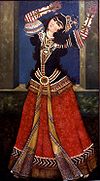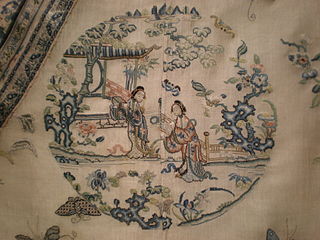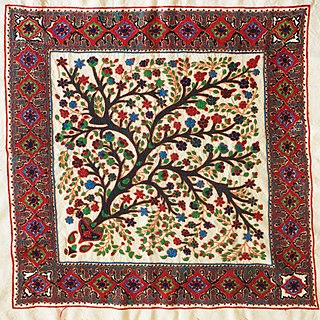| Part of a series on the |
| Culture of Iran |
|---|
 |
| |
Persian embroidery is a type of Persian art and handicraft. [1]
| Part of a series on the |
| Culture of Iran |
|---|
 |
| |
Persian embroidery is a type of Persian art and handicraft. [1]
It has been speculated that Persian embroidery existed from ancient times and at least from the time of the Sasanian Empire, based on numerous designs visible on rock sculptures and silverware of that period, [2] and have been classified by Professor Ernst Herzfeld. Patterns on the coat of Chosroes II at Taq-e Bostan are in high relief; they may represent embroidery. Roundels, animals, and other familiar motifs of Sasanian art were also used as patterns for sculptures representing embroidery.
The earliest piece of physical Persian embroidery is from the Seljuk Empire (1037–1194 A.D.); [2] it featured a strong Chinese-style pattern influencing the design. [2] The Chinese style of embroidery of this time featured a satin stitch (Persian: ṭirāz) made of silk thread and was applied mainly for ornamentation purposes. [2] [3]
The chain stitch (Persian: gulab-duzi) was used in many types of Persian embroidery, most notably in the regional Rasht embroidery. [4] The embroidery featuring metal tinsel in tulle (Persian: naghdeh-duzi) is a common technique of the Jews of Iran. [3]
Sermeh embroidery (Persian: sermeh-duzi) is an Iranian ancient-style of embroidery with origins that date back to the Achaemenid dynasty (705–330 B.C.E.), and features gold and/or silver embroidery. [5] The gold and silver embroidery (Persian: malileh-duzi) style flourished across Persia and was used for decorating household objects. [3]
Pateh is an Iranian traditional needlework folk art originated in and is largely associated with Kerman province, and traditionally created by women. [6] Pateh needlework is created using silk thread, common designs include the cypress tree and the sun with flourishes of paisley patterns. [6]

Embroidery is the craft of decorating fabric or other materials using a needle to apply thread or yarn. Embroidery may also incorporate other materials such as pearls, beads, quills, and sequins. In modern days, embroidery is usually seen on caps, hats, coats, overlays, blankets, dress shirts, denim, dresses, stockings, scarfs, and golf shirts. Embroidery is available in a wide variety of thread or yarn colour. It is often used to personalize gifts or clothing items.

A needlework sampler is a piece of embroidery or cross-stitching produced as a 'specimen of achievement', demonstration or a test of skill in needlework. It often includes the alphabet, figures, motifs, decorative borders and sometimes the name of the person who embroidered it and the date. The word sampler is derived from the Latin exemplum, which means 'example'.

Assisi embroidery is a form of counted-thread embroidery based on an ancient Italian needlework tradition in which the background is filled with embroidery stitches and the main motifs are outlined but not stitched. The name is derived from the Italian town of Assisi where the modern form of the craft originated.

Blackwork, sometimes historically termed Spanish blackwork, is a form of embroidery generally worked in black thread, although other colours are also used on occasion, as in scarletwork, where the embroidery is worked in red thread. Originating in Tudor period England, blackwork typically, though not always, takes the form of a counted-thread embroidery, where the warp and weft yarns of a fabric are counted for the length of each stitch, producing uniform-length stitches and a precise pattern on an even-weave fabric. Blackwork may also take the form of free-stitch embroidery, where the yarns of a fabric are not counted while sewing.

Hardanger embroidery or "Hardangersøm" is a form of embroidery traditionally worked with white thread on white even-weave linen or cloth, using counted thread and drawn thread work techniques. It is sometimes called whitework embroidery.

Berlin wool work is a style of embroidery similar to today's needlepoint that was particularly popular in Europe and America from 1804 to 1875. It is typically executed with wool yarn on canvas, worked in a single stitch such as cross stitch or tent stitch, although Beeton's book of Needlework (1870) describes 15 different stitches for use in Berlin work. It was traditionally stitched in many colours and hues, producing intricate three-dimensional looks by careful shading. Silk or beads were frequently used as highlights. The design of such embroidery was made possible by the great progress made in dyeing, initially with new mordants and chemical dyes, followed in 1856, especially by the discovery of aniline dyes, which produced bright colors.

Crewel embroidery, or crewelwork, is a type of surface embroidery using wool. A wide variety of different embroidery stitches are used to follow a design outline applied to the fabric. The technique is at least a thousand years old.
Needlepoint is a type of canvas work, a form of embroidery in which yarn is stitched through a stiff open weave canvas. Traditionally needlepoint designs completely cover the canvas. Although needlepoint may be worked in a variety of stitches, many needlepoint designs use only a simple tent stitch and rely upon color changes in the yarn to construct the pattern. Needlepoint is the oldest form of canvas work.

Chain stitch is a sewing and embroidery technique in which a series of looped stitches form a chain-like pattern. Chain stitch is an ancient craft – examples of surviving Chinese chain stitch embroidery worked in silk thread have been dated to the Warring States period. Handmade chain stitch embroidery does not require that the needle pass through more than one layer of fabric. For this reason the stitch is an effective surface embellishment near seams on finished fabric. Because chain stitches can form flowing, curved lines, they are used in many surface embroidery styles that mimic "drawing" in thread.

Darning is a sewing technique for repairing holes or worn areas in fabric or knitting using needle and thread alone. It is often done by hand, but it is also possible to darn with a sewing machine. Hand darning employs the darning stitch, a simple running stitch in which the thread is "woven" in rows along the grain of the fabric, with the stitcher reversing direction at the end of each row, and then filling in the framework thus created, as if weaving. Darning is a traditional method for repairing fabric damage or holes that do not run along a seam, and where patching is impractical or would create discomfort for the wearer, such as on the heel of a sock.

Goldwork is the art of embroidery using metal threads. It is particularly prized for the way light plays on it. The term "goldwork" is used even when the threads are imitation gold, silver, or copper. The metal wires used to make the threads have never been entirely gold; they have always been gold-coated silver or cheaper metals, and even then the "gold" often contains a very low percent of real gold. Most metal threads are available in silver and sometimes copper as well as gold; some are available in colors as well.
Iranian handicrafts are handicraft or handmade crafted works originating from Iran.

Chinese embroidery refers to embroidery created by any of the cultures located in the area that makes up modern China. It is some of the oldest extant needlework. The four major regional styles of Chinese embroidery are Suzhou embroidery, Hunan embroidery, Guangdong embroidery and Sichuan embroidery. All of them are nominated as Chinese Intangible Cultural Heritage.

English embroidery includes embroidery worked in England or by English people abroad from Anglo-Saxon times to the present day. The oldest surviving English embroideries include items from the early 10th century preserved in Durham Cathedral and the 11th century Bayeux Tapestry, if it was worked in England. The professional workshops of Medieval England created rich embroidery in metal thread and silk for ecclesiastical and secular uses. This style was called Opus Anglicanum or "English work", and was famous throughout Europe.
Sermeh embroidery, also known as Sormeh embroidery, is an Iranian ancient-style of embroidery. Its origin dates back to the Achaemenid dynasty. It reached its zenith in the Safavid Dynasty. In this style of embroidery, gold and silver threads would be used to make decorating patterns on the surface of fabric; however, nowadays, almost entirely, threads twisted out of cheaper metals and alloys and metal like yarns have replaced gold and silver. The yarn used in patterning is springlike and elastic. Sermeh embroidery is the most popular in the cities of Isfahan, Yazd, Kashan.

Pateh is an Iranian traditional needlework folk art. It originated in and is largely associated with Kerman province, where it is produced by women. A wide piece of wool fabric (ariz) is needleworked with colored thread.

Suzhou embroidery, Su embroidery or Su xiu is the embroidery created around the city of Suzhou, Jiangsu, China. It is one of the oldest embroidery techniques in the world and is the most representative type of art in Chinese embroidery. One of the well-known "four great embroideries of China" along with Cantonese embroidery, Sichuan embroidery and Xiang embroidery, Suzhou embroidery already has a history more than 2,000 years and is an important form of handicraft in the history of Chinese art and folk custom, representative of Chinese traditional folk arts. It is famous for its variety of stitches, beautiful patterns, elegant colors, and consummate craftsmanship.

Balochi needlework is a type of handicraft made by the Baloch people. It is considered a heritage art, has been recognized by UNESCO, and it sells internationally.

Rasht embroidery is a Persian art and handicraft. It is a decorative felt panel with a fine detail chain stitch embroidery, originating in the city of Rasht in Gilan province, Iran. This style of craft flourished in the 16th and 17th centuries in what is now Northwest Iran.

Sistan embroidery is a type of needlework often used to decorate clothing along the chest and the cuffs, from the Sistan and Baluchestan Province of Iran. Additionally this needlework can be found on tablecloths, rugs, cushions, bedspreads, and wedding tables.